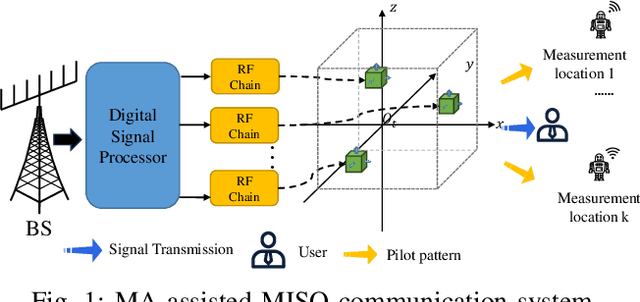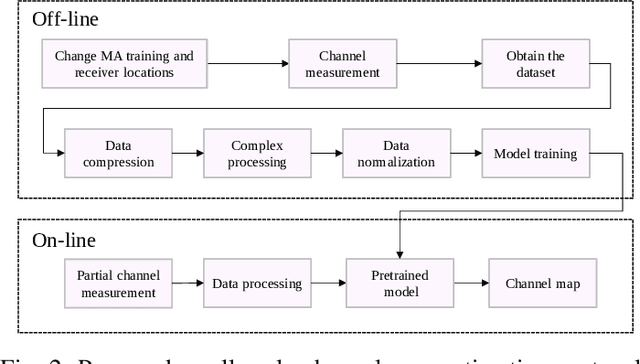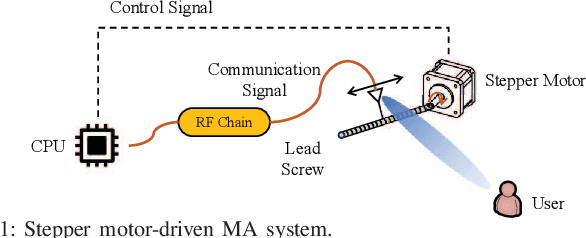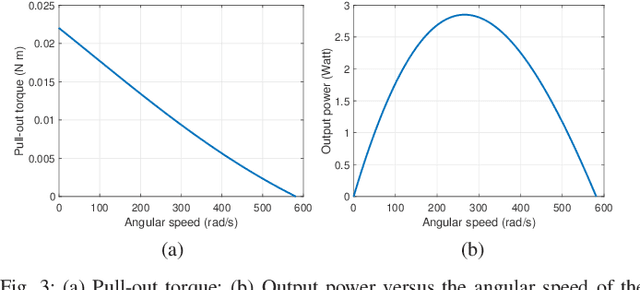Boyu Ning
Performance Optimization for Movable Antenna Enhanced MISO-OFDM Systems
Oct 02, 2025



Abstract:Movable antenna (MA) technology offers a flexible approach to enhancing wireless channel conditions by adjusting antenna positions within a designated region. While most existing works focus on narrowband MA systems, this paper investigates MA position optimization for an MA-enhanced multiple-input single-output (MISO) orthogonal frequency-division multiplexing (OFDM) system. This problem appears to be particularly challenging due to the frequency-flat nature of MA positioning, which should accommodate the channel conditions across different subcarriers. To overcome this challenge, we discretize the movement region into a multitude of sampling points, thereby converting the continuous position optimization problem into a discrete point selection problem. Although this problem is combinatorial, we develop an efficient partial enumeration algorithm to find the optimal solution using a branch-and-bound framework, where a graph-theoretic method is incorporated to effectively prune suboptimal solutions. In the low signal-to-noise ratio (SNR) regime, a simplified graph-based algorithm is also proposed to obtain the optimal MA positions without the need for enumeration. Simulation results reveal that the proposed algorithm outperforms conventional fixed-position antennas (FPAs), while narrowband-based antenna position optimization can achieve near-optimal performance.
Radiation Pattern Reconfigurable FAS-Empowered Interference-Resilient UAV Communication
Oct 01, 2025Abstract:The widespread use of uncrewed aerial vehicles (UAVs) has propelled the development of advanced techniques on countering unauthorized UAV flights. However, the resistance of legal UAVs to illegal interference remains under-addressed. This paper proposes radiation pattern reconfigurable fluid antenna systems (RPR-FAS)-empowered interference-resilient UAV communication scheme. This scheme integrates the reconfigurable pixel antenna technology, which provides each antenna with an adjustable radiation pattern. Therefore, RPR-FAS can enhance the angular resolution of a UAV with a limited number of antennas, thereby improving spectral efficiency (SE) and interference resilience. Specifically, we first design dedicated radiation pattern adapted from 3GPP-TR-38.901, where the beam direction and half power beamwidth are tailored for UAV communications. Furthermore, we propose a low-storage-overhead orthogonal matching pursuit multiple measurement vectors algorithm, which accurately estimates the angle-of-arrival (AoA) of the communication link, even in the single antenna case. Particularly, by utilizing the Fourier transform to the radiation pattern gain matrix, we design a dimension-reduction technique to achieve 1--2 order-of-magnitude reduction in storage requirements. Meanwhile, we propose a maximum likelihood interference AoA estimation method based on the law of large numbers, so that the SE can be further improved. Finally, alternating optimization is employed to obtain the optimal uplink radiation pattern and combiner, while an exhaustive search is applied to determine the optimal downlink pattern, complemented by the water-filling algorithm for beamforming. Comprehensive simulations demonstrate that the proposed schemes outperform traditional methods in terms of angular sensing precision and spectral efficiency.
Integrating Movable Antennas and Intelligent Reflecting Surfaces (MA-IRS): Fundamentals, Practical Solutions, and Opportunities
Jun 17, 2025



Abstract:Movable antennas (MAs) and intelligent reflecting surfaces (IRSs) enable active antenna repositioning and passive phase-shift tuning for channel reconfiguration, respectively. Integrating MAs and IRSs boosts spatial degrees of freedom, significantly enhancing wireless network capacity, coverage, and reliability. In this article, we first present the fundamentals of MA-IRS integration, involving clarifying the key design issues, revealing performance gain, and identifying the conditions where MA-IRS synergy persists. Then, we examine practical challenges and propose pragmatic design solutions, including optimization schemes, hardware architectures, deployment strategies, and robust designs for hardware impairments and mobility management. In addition, we highlight how MA-IRS architectures uniquely support advanced integrated sensing and communication, enhancing sensing performance and dual-functional flexibility. Overall, MA-IRS integration emerges as a compelling approach toward next-generation reconfigurable wireless systems.
Spectral Efficiency Maximization for DMA-enabled Multiuser MISO with Statistical CSI
Jun 11, 2025Abstract:Dynamic metasurface antennas (DMAs) offer the potential to achieve large-scale antenna arrays with low power consumption and reduced hardware costs, making them a promising technology for future communication systems. This paper investigates the spectral efficiency (SE) of DMA-enabled multiuser multiple-input single-output (MISO) systems in both uplink and downlink transmissions, using only statistical channel state information (CSI) to maximize the ergodic sum rate of multiple users. For the uplink system, we consider two decoding rules: minimum mean square error (MMSE) with and without successive interference cancellation (SIC). For both decoders, we derive closed-form surrogates to substitute the original expressions of ergodic sum rate and formulate tractable optimization problems for designing DMA weights. Then, a weighted MMSE (WMMSE)-based algorithm is proposed to maximize the ergodic sum rate. For the downlink system, we derive an approximate expression for the ergodic sum rate and formulate a hybrid analog/digital beamforming optimization problem that jointly optimizes the digital precoder and DMA weights. A penalty dual decomposition (PDD)-based algorithm is proposed by leveraging the fractional programming framework. Numerical results validate the accuracy of the derived surrogates and highlight the superiority of the proposed algorithms over baseline schemes. It is shown that these algorithms are effective across various DMA settings and are particularly well-suited for system design in fast time-varying channels.
CNN-Based Channel Map Estimation for Movable Antenna Systems
May 27, 2025



Abstract:Movable antenna (MA) has attracted increasing attention in wireless communications due to its capability of wireless channel reconfiguration through local antenna movement within a confined region at the transmitter/receiver. However, to determine the optimal antenna positions, channel state information (CSI) within the entire region, termed small-scale channel map, is required, which poses a significant challenge due to the unaffordable overhead for exhaustive channel estimation at all positions. To tackle this challenge, in this paper, we propose a new convolutional neural network (CNN)-based estimation scheme to reconstruct the small-scale channel map within a three-dimensional (3D) movement region. Specifically, we first collect a set of CSI measurements corresponding to a subset of MA positions and different receiver locations offline to comprehensively capture the environmental features. Subsequently, we train a CNN using the collected data, which is then used to reconstruct the full channel map during real-time transmission only based on a finite number of channel measurements taken at several selected MA positions within the 3D movement region. Numerical results demonstrate that our proposed scheme can accurately reconstruct the small-scale channel map and outperforms other benchmark schemes.
Robust Movable-Antenna Position Optimization with Imperfect CSI for MISO Systems
May 11, 2025Abstract:Movable antenna (MA) technology has emerged as a promising solution for reconfiguring wireless channel conditions through local antenna movement within confined regions. Unlike previous works assuming perfect channel state information (CSI), this letter addresses the robust MA position optimization problem under imperfect CSI conditions for a multiple-input single-output (MISO) MA system. Specifically, we consider two types of CSI errors: norm-bounded and randomly distributed errors, aiming to maximize the worst-case and non-outage received signal power, respectively. For norm-bounded CSI errors, we derive the worst-case received signal power in closed-form. For randomly distributed CSI errors, due to the intractability of the probabilistic constraints, we apply the Bernstein-type inequality to obtain a closed-form lower bound for the non-outage received signal power. Based on these results, we show the optimality of the maximum-ratio transmission for imperfect CSI in both scenarios and employ a graph-based algorithm to obtain the optimal MA positions. Numerical results show that our proposed scheme can even outperform other benchmark schemes implemented under perfect CSI conditions.
Mechanical Power Modeling and Energy Efficiency Maximization for Movable Antenna Systems
May 09, 2025



Abstract:Movable antennas (MAs) have recently garnered significant attention in wireless communications due to their capability to reshape wireless channels via local antenna movement within a confined region. However, to achieve accurate antenna movement, MA drivers introduce non-negligible mechanical power consumption, rendering energy efficiency (EE) optimization more critical compared to conventional fixed-position antenna (FPA) systems. To address this problem, we develop in this paper a fundamental power consumption model for stepper motor-driven MA systems by resorting to basic electric motor theory. Based on this model, we formulate an EE maximization problem by jointly optimizing an MA's position, moving speed, and transmit power. However, this problem is difficult to solve optimally due to the intricate relationship between the mechanical power consumption and the design variables. To tackle this issue, we first uncover a hidden monotonicity of the EE performance with respect to the MA's moving speed. Then, we apply the Dinkelbach algorithm to obtain the optimal transmit power in a semi-closed form for any given MA position, followed by an enumeration to determine the optimal MA position. Numerical results demonstrate that despite the additional mechanical power consumption, the MA system can outperform the conventional FPA system in terms of EE.
Advancing THz Radio Map Construction and Obstacle Sensing: An Integrated Generative Framework in ISAC
Mar 29, 2025Abstract:Integrated sensing and communication (ISAC) in the terahertz (THz) band enables obstacle detection, which in turn facilitates efficient beam management to mitigate THz signal blockage. Simultaneously, a THz radio map, which captures signal propagation characteristics through the distribution of received signal strength (RSS), is well-suited for sensing, as it inherently contains obstacle-related information and reflects the unique properties of the THz channel. This means that communication-assisted sensing in ISAC can be effectively achieved using a THz radio map. However, constructing a radio map presents significant challenges due to the sparse deployment of THz sensors and their limited ability to accurately measure the RSS distribution, which directly affects obstacle sensing. In this paper, we formulate an integrated problem for the first time, leveraging the mutual enhancement between sensed obstacles and the constructed THz radio maps. To address this challenge while improving generalization, we propose an integration framework based on a conditional generative adversarial network (CGAN), which uncovers the manifold structure of THz radio maps embedded with obstacle information. Furthermore, recognizing the shared environmental semantics across THz radio maps from different beam directions, we introduce a novel voting-based sensing scheme, where obstacles are detected by aggregating votes from THz radio maps generated by the CGAN. Simulation results demonstrate that the proposed framework outperforms non-integrated baselines in both radio map construction and obstacle sensing, achieving up to 44.3% and 90.6% reductions in mean squared error (MSE), respectively, in a real-world scenario. These results validate the effectiveness of the proposed voting-based scheme.
Flexible Intelligent Metasurface-Aided Wireless Communications: Architecture and Performance
Mar 14, 2025



Abstract:Typical reconfigurable intelligent surface (RIS) implementations include metasurfaces with almost passive unit elements capable of reflecting their incident waves in controllable ways, enhancing wireless communications in a cost-effective manner. In this paper, we advance the concept of intelligent metasurfaces by introducing a flexible array geometry, termed flexible intelligent metasurface (FIM), which supports both element movement (EM) and passive beamforming (PBF). In particular, based on the single-input single-output (SISO) system setup, we first compare three modes of FIM, namely, EM-only, PBF-only, and EM-PBF, in terms of received signal power under different FIM and channel setups. The PBF-only mode, which only adjusts the reflect phase, is shown to be less effective than the EM-only mode in enhancing received signal strength. In a multi-element, multi-path scenario, the EM-only mode improves the received signal power by 125% compared to the PBF-only mode. The EM-PBF mode, which optimizes both element positions and phases, further enhances performance. Additionally, we investigate the channel estimation problem for FIM systems by designing a protocol that gathers EM and PBF measurements, enabling the formulation of a compressive sensing problem for joint cascaded and direct channel estimation. We then propose a sparse recovery algorithm called clustering mean-field variational sparse Bayesian learning, which enhances estimation performance while maintaining low complexity.
Modeling and Optimization for Flexible Cylindrical Arrays-Enabled Wireless Communications
Mar 14, 2025Abstract:Flexible-geometry arrays have garnered much attention in wireless communications, which dynamically adjust wireless channels to improve the system performance. In this paper, we propose a novel flexible-geometry array for a $360^\circ$ coverage, named flxible cylindrical array (FCLA), comprised of multiple flexible circular arrays (FCAs). The elements in each FCA can revolve around the circle track to change their horizontal positions, and the FCAs can move along the vertical axis to change the elements' heights. Considering that horizontal revolving can change the antenna orientation, we adopt both the omni-directional and the directional antenna patterns. Based on the regularized zero-forcing (RZF) precoding scheme, we formulate a particular compressive sensing (CS) problem incorporating joint precoding and antenna position optimization, and propose two effective methods, namely FCLA-J and FCLA-A, to solve it. Specifically, the first method involves jointly optimizing the element's revolving angle, height, and precoding coefficient within a single CS framework. The second method decouples the CS problem into two subproblems by utilizing an alternative sparse optimization approach for the revolving angle and height, thereby reducing time complexity. Simulation results reveal that, when utilizing directional radiation patterns, FCLA-J and FCLA-A achieve substantial performance improvements of 43.32\% and 25.42\%, respectively, compared to uniform cylindrical arrays (UCLAs) with RZF precoding.
 Add to Chrome
Add to Chrome Add to Firefox
Add to Firefox Add to Edge
Add to Edge